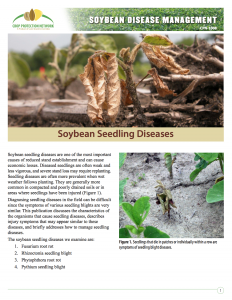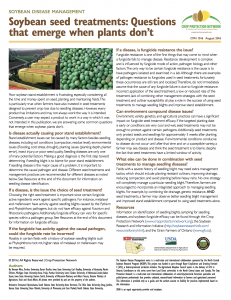Scouting for Soybean Seedling Diseases
Damon Smith, Extension Field Crops Pathologist, Department of Plant Pathology, University of Wisconsin-Madison
The 2017 planting season has been frustrating for many farmers with frequent rains, wet soils, and cool temperatures. These conditions have resulted in slow, or no planting, for some farmers. To add insult to injury, these conditions are also conducive for many seedling diseases of soybean. The Crop Protection Network, which the UW Field Crops Pathology program is a part of, has generated several useful publications for diagnosing and managing soybean seedling diseases.
The first publication is a full length fact sheet titled “Soybean Seedling Diseases.” This publication can help you differentiate seedling diseases and also herbicide injury, both of which could be issues for many farmers this season.
Speaking of herbicide issues, the CPN has also generated a useful publication on using ILeVO® seed treatment on soybean. Many farmers in Wisconsin have considering using ILeVO® to manage sudden death syndrome and soybean cyst nematode. Farmers should be aware that it is well known that ILeVO® can cause some phytotoxicity to soybean that looks similar to a soybean seedling disease. A useful fact sheet on this phenomenon can be found by clicking here.
Many farmers have elected to use a seed treatment (fungicide, insecticide, nematicide or combination) to protect their seed investment. This is a wise decision, especially considering the cool wet soils that many of us have planted into this season. However, just because a seed treatment was used, there still can be emergence issues. To aid in understanding these issues, the CPN has generated a “Soybean Seed Treatments: Questions that emerge when plants don’t.”
Finally, if conditions remain wet, Phytopthora root and stem rot may affect soybean stands early to mid-season. The CPN has developed a resource which can be found by clicking here. The UW Field Crops Pathology program has also generated a similar fact sheet on Phytopthora root and stem rot that can be found by clicking here.
As always, if you have questions about diseases of soybean, or any field crop, please contact and we can assist in diagnosing and developing a management strategy.




